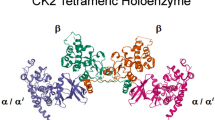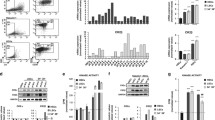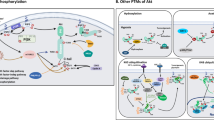Abstract
CK2 and Akt (also known as PKB) are two antiapoptotic protein kinases, which phosphorylate hundreds of substrates. While CK2 is constitutively active, Akt, under physiological conditions, is activated by external growth/proliferation signals. However, in cancer, on the one hand, the mechanism of Akt activation is frequently dysregulated and, on the other, CK2 is usually overexpressed. Both kinases are therefore involved in tumorigenesis and considered promising drug targets.
CK2 profoundly intersects the Akt signaling: it phosphorylates several components of the Akt pathway, producing positive effects on stimulatory elements while blocking the inhibitory ones. The final outcome is that CK2 potentiates the Akt survival message.
Here we summarize the major contact points between the two kinases, focusing on the direct connection due to the CK2-dependent phosphorylation of Akt1 Ser129, but also on different levels of integration, spanning from the Akt activation mechanism at plasma membrane to the downstream effectors. It will be also highlighted how this orchestrated circuitry involving Akt and CK2 is aberrantly amplified under certain pathological circumstances, offering sites for therapeutic intervention. However, we will also review recent findings concerning specific regulation of different Akt isoforms by CK2, which can explain some of their divergent functions and warn against a too cursory pharmacological targeting of CK2/Akt, which instead can be planned only once a comprehensive picture of their connections in a specific tumor cell type has been depicted.
Access this chapter
Tax calculation will be finalised at checkout
Purchases are for personal use only
Similar content being viewed by others
Abbreviations
- AML:
-
Acute myeloid leukemia
- B-ALL:
-
B-cell acute lymphoblastic leukemia
- CLL:
-
Chronic lymphocytic leukemia
- CML:
-
Chronic myeloid leukemia
- Fbxo9:
-
F-box only protein 9
- GF:
-
Growth factor
- NEP:
-
Neprilysin
- PAF:
-
Platelet-activating factor
- PD-1:
-
Receptor programmed death 1
- PH:
-
Pleckstrin homology
- PHLPP:
-
Pleckstrin homology domain leucine-rich repeat protein phosphatase
- PI3K:
-
Phosphoinositide 3-kinase
- PIP3 :
-
Phosphatidylinositol-3,4,5-trisphosphate
- Plk3:
-
Polo-like kinase 3
- PML:
-
Promyelocytic leukemia gene
- PP2A:
-
Protein phosphatase 2A
- T-ALL:
-
T-cell acute lymphoblastic leukemia
- Tel2:
-
Telomere maintenance 2
- TIF-1A:
-
Transcription initiation factor I
- Tti1:
-
Tel2-interacting protein 1
References
Pinna LA (2002) Protein kinase CK2: a challenge to canons. J Cell Sci 115:3873–3878
Meggio F, Pinna LA (2003) One-thousand-and-one substrates of protein kinase CK2? FASEB J 17:349–368
Ahmed K, Gerber DA, Cochet C (2002) Joining the cell survival squad: an emerging role for protein kinase CK2. Trends Cell Biol 12:226–230
Ahmad KA, Wang G, Unger G et al (2008) Protein kinase CK2 – a key suppressor of apoptosis. Adv Enzyme Regul 48:179–187
St-Denis NA, Litchfield DW (2009) Protein kinase CK2 in health and disease: from birth to death: the role of protein kinase CK2 in the regulation of cell proliferation and survival. Cell Mol Life Sci 66:1817–1829
Ruzzene M, Pinna LA (2010) Addiction to protein kinase CK2: a common denominator of diverse cancer cells? Biochim Biophys Acta 1804:499–504
Sale EM, Sale GJ (2008) Protein kinase B: signalling roles and therapeutic targeting. Cell Mol Life Sci 65:113–127
Manning BD, Cantley LC (2007) AKT/PKB signaling: navigating downstream. Cell 129:1261–1274
Fayard E, Tintignac LA, Baudry A et al (2005) Protein kinase B/Akt at a glance. J Cell Sci 118:5675–5678
Bozulic L, Surucu B, Hynx D et al (2008) PKBalpha/Akt1 acts downstream of DNA-PK in the DNA double-strand break response and promotes survival. Mol Cell 30:203–213
Alessi DR, Cohen P (1998) Mechanism of activation and function of protein kinase B. Curr Opin Genet Dev 8:55–62
Brognard J, Sierecki E, Gao T et al (2007) PHLPP and a second isoform, PHLPP2, differentially attenuate the amplitude of Akt signaling by regulating distinct Akt isoforms. Mol Cell 25:917–931
Toker A (2012) Achieving specificity in Akt signaling in cancer. Adv Biol Regul 52:78–87
Cantley LC, Neel BG (1999) New insights into tumor suppression: PTEN suppresses tumor formation by restraining the phosphoinositide 3-kinase/AKT pathway. Proc Natl Acad Sci U S A 96:4240–4245
Di Cristofano A, Pandolfi PP (2000) The multiple roles of PTEN in tumor suppression. Cell 100:387–390
Torres J, Pulido R (2001) The tumor suppressor PTEN is phosphorylated by the protein kinase CK2 at its C terminus. Implications for PTEN stability to proteasome-mediated degradation. J Biol Chem 276:993–998
Miller SJ, Lou DY, Seldin DC et al (2002) Direct identification of PTEN phosphorylation sites. FEBS Lett 528:145–153
Vazquez F, Grossman SR, Takahashi Y et al (2001) Phosphorylation of the PTEN tail acts as an inhibitory switch by preventing its recruitment into a protein complex. J Biol Chem 276:48627–48630
Silva A, Yunes JA, Cardoso BA et al (2008) PTEN posttranslational inactivation and hyperactivation of the PI3K/Akt pathway sustain primary T cell leukemia viability. J Clin Invest 118:3762–3774
Gomes AM, Soares MV, Ribeiro P et al (2014) Adult B-cell acute lymphoblastic leukemia cells display decreased PTEN activity and constitutive hyperactivation of PI3K/Akt pathway despite high PTEN protein levels. Haematologica 99:1062–1068
He L, Fan C, Gillis A et al (2007) Co-existence of high levels of the PTEN protein with enhanced Akt activation in renal cell carcinoma. Biochim Biophys Acta 1772:1134–1142
Al-Khouri AM, Ma Y, Togo SH et al (2005) Cooperative phosphorylation of the tumor suppressor phosphatase and tensin homologue (PTEN) by casein kinases and glycogen synthase kinase 3beta. J Biol Chem 280:35195–35202
Xu D, Yao Y, Jiang X et al (2010) Regulation of PTEN stability and activity by Plk3. J Biol Chem 285:39935–39942
Siepmann M, Kumar S, Mayer G et al (2010) Casein kinase 2 dependent phosphorylation of neprilysin regulates receptor tyrosine kinase signaling to Akt. PLoS One 5:e13134
Patsoukis N, Li L, Sari D et al (2013) PD-1 increases PTEN phosphatase activity while decreasing PTEN protein stability by inhibiting casein kinase 2. Mol Cell Biol 33:3091–3098
Kang NI, Yoon HY, Kim HA et al (2011) Protein kinase CK2/PTEN pathway plays a key role in platelet-activating factor-mediated murine anaphylactic shock. J Immunol 186:6625–6632
Ning K, Miller LC, Laidlaw HA et al (2006) A novel leptin signalling pathway via PTEN inhibition in hypothalamic cell lines and pancreatic beta-cells. EMBO J 25:2377–2387
Heiker JT, Wottawah CM, Juhl C et al (2009) Protein kinase CK2 interacts with adiponectin receptor 1 and participates in adiponectin signaling. Cell Signal 21:936–942
Barata JT (2011) The impact of PTEN regulation by CK2 on PI3K-dependent signaling and leukemia cell survival. Adv Enzyme Regul 51:37–49
Di Maira G, Salvi M, Arrigoni G et al (2005) Protein kinase CK2 phosphorylates and upregulates Akt/PKB. Cell Death Differ 12:668–677
Kim JS, Eom JI, Cheong JW et al (2007) Protein kinase CK2alpha as an unfavorable prognostic marker and novel therapeutic target in acute myeloid leukemia. Clin Cancer Res 13:1019–1028
Cheong JW, Min YH, Eom JI et al (2010) Inhibition of CK2{alpha} and PI3K/Akt synergistically induces apoptosis of CD34 + CD38− leukaemia cells while sparing haematopoietic stem cells. Anticancer Res 30:4625–4634
Shehata M, Schnabl S, Demirtas D et al (2010) Reconstitution of PTEN activity by CK2 inhibitors and interference with the PI3-K/Akt cascade counteract the antiapoptotic effect of human stromal cells in chronic lymphocytic leukemia. Blood 116:2513–2521
Borgo C, Cesaro L, Salizzato V et al (2013) Aberrant signalling by protein kinase CK2 in imatinib-resistant chronic myeloid leukaemia cells: biochemical evidence and therapeutic perspectives. Mol Oncol 7:1103–1115
Buontempo F, Orsini E, Martins LR et al (2014) Cytotoxic activity of the casein kinase 2 inhibitor CX-4945 against T-cell acute lymphoblastic leukemia: targeting the unfolded protein response signaling. Leukemia 28:543–553
Ryu BJ, Baek SH, Kim J et al (2012) Anti-androgen receptor activity of apoptotic CK2 inhibitor CX4945 in human prostate cancer LNCap cells. Bioorg Med Chem Lett 22:5470–5474
Chatterjee A, Chatterjee U, Ghosh MK (2013) Activation of protein kinase CK2 attenuates FOXO3a functioning in a PML-dependent manner: implications in human prostate cancer. Cell Death Dis 4:e543
Pierre F, Chua PC, O'Brien SE et al (2011) Pre-clinical characterization of CX-4945, a potent and selective small molecule inhibitor of CK2 for the treatment of cancer. Mol Cell Biochem 356:37–43
Noh EM, Lee YR, Chay KO et al (2011) Estrogen receptor alpha induces down-regulation of PTEN through PI3-kinase activation in breast cancer cells. Mol Med Rep 4:215–219
Stahl S, Branca RM, Efazat G et al (2011) Phosphoproteomic profiling of NSCLC cells reveals that ephrin B3 regulates pro-survival signaling through Akt1-mediated phosphorylation of the EphA2 receptor. J Proteome Res 10:2566–2578
Bliesath J, Huser N, Omori M et al (2012) Combined inhibition of EGFR and CK2 augments the attenuation of PI3K-Akt-mTOR signaling and the killing of cancer cells. Cancer Lett 322:113–118
Ku MJ, Park JW, Ryu BJ et al (2013) CK2 inhibitor CX4945 induces sequential inactivation of proteins in the signaling pathways related with cell migration and suppresses metastasis of A549 human lung cancer cells. Bioorg Med Chem Lett 23:5609–5613
Olsen BB, Svenstrup TH, Guerra B (2012) Downregulation of protein kinase CK2 induces autophagic cell death through modulation of the mTOR and MAPK signaling pathways in human glioblastoma cells. Int J Oncol 41:1967–1976
Zheng Y, McFarland BC, Drygin D et al (2013) Targeting protein kinase CK2 suppresses prosurvival signaling pathways and growth of glioblastoma. Clin Cancer Res 19:6484–6494
Parker R, Clifton-Bligh R, Molloy MP (2014) Phosphoproteomics of MAPK inhibition in BRAF mutated cells and a role for the lethal synergism of dual BRAF and CK2 inhibition. Mol Cancer Ther 13(7):1894–1906
Zanin S, Borgo C, Girardi C et al (2012) Effects of the CK2 inhibitors CX-4945 and CX-5011 on drug-resistant cells. PLoS One 7:e49193
Di Maira G, Brustolon F, Pinna LA et al (2009) Dephosphorylation and inactivation of Akt/PKB is counteracted by protein kinase CK2 in HEK 293T cells. Cell Mol Life Sci 66:3363–3373
Sato S, Fujita N, Tsuruo T (2000) Modulation of Akt kinase activity by binding to Hsp90. Proc Natl Acad Sci U S A 97:10832–10837
Ponce DP, Maturana JL, Cabello P et al (2011) Phosphorylation of AKT/PKB by CK2 is necessary for the AKT-dependent up-regulation of beta-catenin transcriptional activity. J Cell Physiol 226:1953–1959
Calleja V, Laguerre M, Parker PJ et al (2009) Role of a novel PH-kinase domain interface in PKB/Akt regulation: structural mechanism for allosteric inhibition. PLoS Biol 7:e17
Wu WI, Voegtli WC, Sturgis HL et al (2010) Crystal structure of human AKT1 with an allosteric inhibitor reveals a new mode of kinase inhibition. PLoS One 5:e12913
Guerra B (2006) Protein kinase CK2 subunits are positive regulators of AKT kinase. Int J Oncol 28:685–693
le Nguyen XT, Mitchell BS (2013) Akt activation enhances ribosomal RNA synthesis through casein kinase II and TIF-IA. Proc Natl Acad Sci U S A 110:20681–20686
Scaglioni PP, Yung TM, Cai LF et al (2006) A CK2-dependent mechanism for degradation of the PML tumor suppressor. Cell 126:269–283
Trotman LC, Alimonti A, Scaglioni PP et al (2006) Identification of a tumour suppressor network opposing nuclear Akt function. Nature 441:523–527
Miyata Y, Nishida E (2004) CK2 controls multiple protein kinases by phosphorylating a kinase-targeting molecular chaperone, Cdc37. Mol Cell Biol 24:4065–4074
Fernandez-Saiz V, Targosz BS, Lemeer S et al (2013) SCFFbxo9 and CK2 direct the cellular response to growth factor withdrawal via Tel2/Tti1 degradation and promote survival in multiple myeloma. Nat Cell Biol 15:72–81
Zoncu R, Efeyan A, Sabatini DM (2011) mTOR: from growth signal integration to cancer, diabetes and ageing. Nat Rev Mol Cell Biol 12:21–35
Wilhelm N, Kostelnik K, Gotz C et al (2012) Protein kinase CK2 is implicated in early steps of the differentiation of pre-adipocytes into adipocytes. Mol Cell Biochem 365:37–45
Al Quobaili F, Montenarh M (2012) CK2 and the regulation of the carbohydrate metabolism. Metabolism 61:1512–1517
Yang ZZ, Tschopp O, Hemmings-Mieszczak M et al (2003) Protein kinase B alpha/Akt1 regulates placental development and fetal growth. J Biol Chem 278:32124–32131
Santi SA, Lee H (2010) The Akt isoforms are present at distinct subcellular locations. Am J Physiol Cell Physiol 298:C580–C591
Bellacosa A, Testa JR, Moore R et al (2004) A portrait of AKT kinases: human cancer and animal models depict a family with strong individualities. Cancer Biol Ther 3:268–275
Stambolic V, Woodgett JR (2006) Functional distinctions of protein kinase B/Akt isoforms defined by their influence on cell migration. Trends Cell Biol 16:461–466
Dillon RL, Muller WJ (2010) Distinct biological roles for the akt family in mammary tumor progression. Cancer Res 70:4260–4264
Chin YM, Yuan X, Balk SP et al (2014) PTEN-deficient tumors depend on Akt2 for maintenance and survival. Cancer Discov 4(8):942–955
Yoeli-Lerner M, Yiu GK, Rabinovitz I et al (2005) Akt blocks breast cancer cell motility and invasion through the transcription factor NFAT. Mol Cell 20:539–550
Chin YR, Toker A (2009) Function of Akt/PKB signaling to cell motility, invasion and the tumor stroma in cancer. Cell Signal 21:470–476
Chin YR, Toker A (2010) The actin-bundling protein palladin is an Akt1-specific substrate that regulates breast cancer cell migration. Mol Cell 38:333–344
Girardi C, James P, Zanin S et al (2014) Differential phosphorylation of Akt1 and Akt2 by protein kinase CK2 may account for isoform specific functions. Biochim Biophys Acta 1843(9):1865–1874
Wani R, Bharathi NS, Field J et al (2011) Oxidation of Akt2 kinase promotes cell migration and regulates G1-S transition in the cell cycle. Cell Cycle 10:3263–3268
Toker A, Yoeli-Lerner M (2006) Akt signaling and cancer: surviving but not moving on. Cancer Res 66:3963–3966
Kreutzer JN, Ruzzene M, Guerra B (2010) Enhancing chemosensitivity to gemcitabine via RNA interference targeting the catalytic subunits of protein kinase CK2 in human pancreatic cancer cells. BMC Cancer 10:440. doi:10.1186/1471-2407-10-440
Pinna LA, Ruzzene M (1996) How do protein kinases recognize their substrates? Biochim Biophys Acta 1314:191–225
Siddiqui-Jain A, Drygin D, Streiner N et al (2010) CX-4945, an orally bioavailable selective inhibitor of protein kinase CK2, inhibits prosurvival and angiogenic signaling and exhibits antitumor efficacy. Cancer Res 70:10288–10298
Author information
Authors and Affiliations
Corresponding author
Editor information
Editors and Affiliations
Rights and permissions
Copyright information
© 2015 Springer International Publishing Switzerland
About this chapter
Cite this chapter
Girardi, C., Ruzzene, M. (2015). CK2 Function in the Regulation of Akt Pathway. In: Ahmed, K., Issinger, OG., Szyszka, R. (eds) Protein Kinase CK2 Cellular Function in Normal and Disease States. Advances in Biochemistry in Health and Disease, vol 12. Springer, Cham. https://doi.org/10.1007/978-3-319-14544-0_8
Download citation
DOI: https://doi.org/10.1007/978-3-319-14544-0_8
Published:
Publisher Name: Springer, Cham
Print ISBN: 978-3-319-14543-3
Online ISBN: 978-3-319-14544-0
eBook Packages: Biomedical and Life SciencesBiomedical and Life Sciences (R0)




